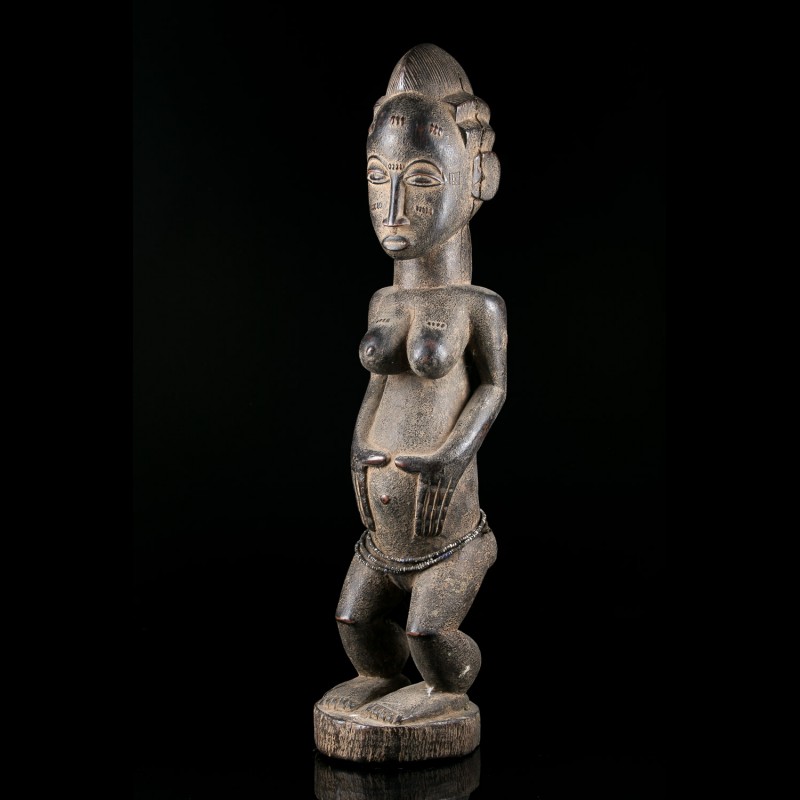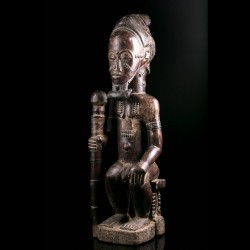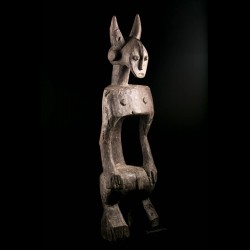










At first glance, one might be tempted to classify this piece as a female ancestor statue, but the Baule never carved statues for their ancestors, even though they believed in their existence. They see the afterlife as another world, "the place of our origin and destination after death; existence, in fact, follows a perpetual rotation from one world to the other, "writes Etienne Feau. In that other world, prior the birth, for each living individual, man or woman, there has already been a marriage; by entering the world on earth, he or she must leave behind a spouse, a lover. Abandoned spouses, if unhappy, can remind their living spouses of their existence by causing different psychological and sexual problems. Someone who finds him or herself in difficulty will consult a diviner-healer. After gessing the root of the problem, the diviner advises his client to have a statuette carved according to precise characteristics. The client will have the diviner consecrate the finished sculpture, then the client brings it home as if it were a genuine spouse. The piece is carefully maintained in a secret place by the client, who dedicated a cult to it, regularly offering it sacrifices in the hope of improving his or her mental or physical health.The statue could be a spirit spouse, abandonned although she was already pregnant. Her face and large, almond-shaped eyes clearly evoke her sadness. She laments her plight, yet everything about her displays great dignity. The care shown in rendering both the scarifications adorning her face and neck, and her hairstyle, indicates that this woman belongs to a rich elite. The sculptor, finally, has respected the traditions of Baule art. The arms are fixed to the torso and the hands set on the belly. The lines are full and round. Refinement, balance, harmony and dignity are the chief qualities that have led collectors to appreciate and acquire Baule sculpture in particular from the start of the last century.60 x 14 cm
Data sheet
You might also like

At first glance, one might be tempted to classify this piece as a female ancestor statue, but the Baule never carved statues for their ancestors, even though they believed in their existence. They see the afterlife as another world, "the place of our origin and destination after death; existence, in fact, follows a perpetual rotation from one world to the other, "writes Etienne Feau. In that other world, prior the birth, for each living individual, man or woman, there has already been a marriage; by entering the world on earth, he or she must leave behind a spouse, a lover. Abandoned spouses, if unhappy, can remind their living spouses of their existence by causing different psychological and sexual problems. Someone who finds him or herself in difficulty will consult a diviner-healer. After gessing the root of the problem, the diviner advises his client to have a statuette carved according to precise characteristics. The client will have the diviner consecrate the finished sculpture, then the client brings it home as if it were a genuine spouse. The piece is carefully maintained in a secret place by the client, who dedicated a cult to it, regularly offering it sacrifices in the hope of improving his or her mental or physical health.The statue could be a spirit spouse, abandonned although she was already pregnant. Her face and large, almond-shaped eyes clearly evoke her sadness. She laments her plight, yet everything about her displays great dignity. The care shown in rendering both the scarifications adorning her face and neck, and her hairstyle, indicates that this woman belongs to a rich elite. The sculptor, finally, has respected the traditions of Baule art. The arms are fixed to the torso and the hands set on the belly. The lines are full and round. Refinement, balance, harmony and dignity are the chief qualities that have led collectors to appreciate and acquire Baule sculpture in particular from the start of the last century.60 x 14 cm

